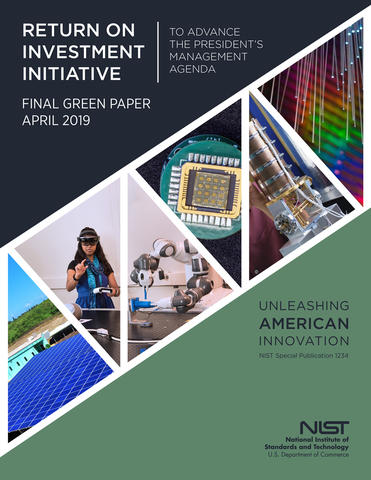
GAITHERSBURG, Md.—Today, the U.S. Department of Commerce’s National Institute of Standards and Technology announced 15 key findings from a final version of a new “green paper” on maximizing U.S. innovation from government-funded research.
Incorporating extensive feedback from industry, academic and government stakeholders, the NIST report describes options for enhancing how federally funded inventions move from the laboratory to the marketplace by:
- streamlining federal regulations,
- enabling greater flexibility for public-private partnerships,
- increasing engagement with private-sector investors,
- building a more entrepreneurial workforce, and
- improving support for innovation by clarifying the intended purpose of “march-in rights.”
The green paper serves as a discussion document that informs, but does not prescribe, policy decisions by the federal government. No findings in this final green paper would require legislative changes to the Bayh-Dole Act.
“The United States has the best universities, research institutes and federal labs in the world, and we need modern approaches that work at the speed of business to get the most from their R&D outcomes,” said Secretary of Commerce Wilbur Ross.
“The accelerating pace of technology innovation and intense competition in the global marketplace demand new solutions,” said Under Secretary of Commerce for Standards and Technology and NIST Director Walter G. Copan. “Removing roadblocks, enabling entrepreneurs, attracting private investment and getting inventions from the laboratory into the marketplace faster are essential to unleash American innovation and to strengthen U.S. economic competitiveness and national security.”
“The U.S. must continue to lead the world in technology, and that means maximizing both the taxpayers’ investment into American R&D and the potential of our nation’s brightest minds across academia, industry and government,” said Deputy Assistant to the President for Technology Policy Michael Kratsios, of the White House Office of Science and Technology Policy (OSTP). “We must ensure the next great inventions are not stifled in regulatory limbo forever, but rather they are brought into the marketplace safely and efficiently for the benefit of the American people.”
The paper is a result of NIST’s Return on Investment Initiative for Unleashing American Innovation. NIST co-leads the effort with OSTP through the President’s Management Agenda and its Lab-to-Market Cross Agency Priority (CAP) goal, which singles out top-priority investment opportunities from across the federal government. This national goal aims to dramatically increase returns from the more than $150 billion per year of U.S. federal investment in research and development (R&D).
To create this green paper, NIST relied on extensive inputs from the private and public sectors, close coordination with OSTP and engagement with federal interagency working groups. Several hundred experts and organizations representing thousands of companies, universities and institutions provided thoughtful comments at forums held across the nation and organized by NIST and the U.S. Patent and Trademark Office. A Request for Information published in the Federal Register in May 2018 and comments on the December 2018 draft green paper also informed the final ROI Initiative Green Paper, NIST Special Publication 1234.
Background
The Bayh-Dole Act of 1980 was landmark legislation for U.S. innovation, and the findings of the green paper underscore the importance of preserving its essential premises. However, federal technology transfer laws, including Bayh-Dole, Stevenson-Wydler and the Federal Technology Transfer Act, were largely written prior to the internet and the emergence of the digital economy.
The green paper notes that in the intervening decades, interpretation of the Bayh-Dole Act has created confusion over the “march-in rights” and “government use license” provisions, and that some stakeholders want clarification. March-in rights described under Bayh-Doyle allow the government, in certain limited circumstances, to force the party with title to a government-funded intellectual property to grant a license to another entity. To date, the government has never exercised these rights.
The green paper discusses ways that march-in rights could be clarified, and federal technology transfer policies and practices improved to enhance innovation effectiveness.
According to stakeholder input for the new NIST document, the federal government could streamline processes and agency authorities to structure agreements that offer greater flexibility and make it easier and more attractive for the private sector and academia to partner with the government. Some stakeholders also identified areas where changes in how the government protects and reports intellectual property, technologies and capabilities could make it easier for the private sector and academia to identify promising partnership and commercial opportunities.
In developing the green paper, NIST partnered with 140 representatives from the National Science and Technology Council’s Lab-to-Market Subcommittee, the Interagency Working Group on Technology Transfer, and the Federal Laboratory Consortium’s Executive Board. Additionally, NIST’s principal advisory body, the Visiting Committee on Advanced Technology, formed a Subcommittee on Technology Transfer to provide the agency with additional expert input.
The report notes that many of the issues or options suggested by stakeholders “fall within the primary shared responsibilities of other agencies and departments.” The green paper is intended to “inform future deliberations, decision-making, and implementing actions by the relevant departments and agencies.” Specific policy, legislative and/or regulatory actions would be decided upon by the relevant departments and agencies using established processes including “appropriate interagency consultations, formal interagency review, and in many cases formal public comment.”
NIST promotes U.S. innovation and industrial competitiveness by advancing measurement science, standards and technology in ways that enhance economic security and improve our quality of life. NIST is a nonregulatory agency of the U.S. Department of Commerce. To learn more about NIST, visit www.nist.gov.

